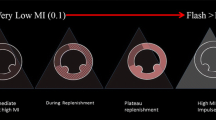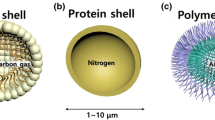Abstract
Patients diagnosed with advanced peripheral arterial disease often face poor prognoses and have limited treatment options. For some patient populations, the therapeutic growth of collateral arteries (i.e. arteriogenesis) that bypass regions affected by vascular disease may become a viable treatment option. Our group and others are developing therapeutic approaches centered on the ability of ultrasound-activated microbubbles to permeabilize skeletal muscle capillaries and facilitate the targeted delivery of pro-arteriogenic growth factor-bearing nanoparticles. The development of such approaches would benefit significantly from a better understanding of how nanoparticle diameter and ultrasound peak-negative pressure affect both total nanoparticle delivery and the partitioning of nanoparticles to endothelial or interstitial compartments. Toward this goal, using Balb/C mice that had undergone unilateral femoral artery ligation, we intra-arterially co-injected nanoparticles (50 and 100 nm) with microbubbles, applied 1 MHz ultrasound to the gracilis adductor muscle at peak-negative pressures of 0.7, 0.55, 0.4, and 0.2 MPa, and analyzed nanoparticle delivery and distribution. As expected, total nanoparticle (50 and 100 nm) delivery increased with increasing peak-negative pressure, with 50 nm nanoparticles exhibiting greater tissue coverage than 100 nm nanoparticles. Of particular interest, increasing peak-negative pressure resulted in increased delivery to the interstitium for both nanoparticle sizes, but had little influence on nanoparticle delivery to the endothelium. Thus, we conclude that alterations to peak-negative pressure may be used to adjust the fraction of nanoparticles delivered to the interstitial compartment. This information will be useful when designing ultrasound protocols for delivering pro-arteriogenic nanoparticles to skeletal muscle.






Similar content being viewed by others
References
Bobek V, Taltynov O, Pinterova D, Kolostova K (2006) Gene therapy of the ischemic lower limb–Therapeutic angiogenesis. Vascul Pharmacol 44:395–405
Burke CW, Hsiang Y-HJ, Alexander E IV, Klibanov AL, Price RJ (2011) Covalently linking poly(lactic-co-glycolic acid) nanoparticles to microbubbles before intravenous injection improves their ultrasound-targeted delivery to skeletal muscle. Small 7:1227–1235
Burke CW, Suk JS, Kim AJ, Hsiang Y-HJ, Klibanov AL, Hanes J, Price RJ (2012) Markedly enhanced skeletal muscle transfection achieved by the ultrasound-targeted delivery of non-viral gene nanocarriers with microbubbles. J Control Release 162:414–421
Caskey C, Stieger S, Qin S, Dayton P, Ferrara K (2007) Direct observations of ultrasound microbubble contrast agent interaction with the microvessel wall. J Acoust Soc Am 122:1191–1200
Chappell JC, Price RJ (2006) Targeted therapeutic applications of acoustically active microspheres in the microcirculation. Microcirculation 13:57–70
Chappell JC, Klibanov AL, Price RJ (2005) Ultrasound-microbubble mediated neovascularization in mouse in skeletal muscle. Ultrasound Med Biol 31:1411–1422
Chappell JC, Song J, Burke CW, Klibanov AL, Price RJ (2008a) Targeted delivery of nanoparticles bearing fibroblast growth factor-2 by ultrasonic microbubble destruction for therapeutic arteriogenesis. Small 4:1769–1777
Chappell JC, Song J, Klibanov AL, Price RJ (2008b) Ultrasonic microbubble destruction stimulates therapeutic arteriogenesis via the CD18-dependent recruitment of bone marrow-derived cells. Arterioscler Thromb Vasc Biol 28:1117–1122
Collis J, Manasseh R, Liovic P, Tho P, Ooi A, Petkovic-Duran K, Zhu Y (2010) Cavitation microstreaming and stress fields created by microbubbles. Ultrasonics 50:273–279
Fan Z, Kumon RE, Park J, Deng CX (2010) Intracellular delivery and calcium transients generated in sonoporation facilitated by microbubbles. J Control Release 142:31–39
Heuslein JL, Li X, Murrell KP, Annex BH, Peirce SM, Price RJ (2015) Computational network model prediction of hemodynamic alterations due to arteriolar rarefaction and estimation of skeletal muscle perfusion in peripheral arterial disease. Microcirculation. doi:10.1111/micc.12203
Juffermans LJM, van Dijk A, Jongenelen CAM, Drukarch B, Reijerkerk A, de Vries HE, Kamp O et al (2009) Ultrasound and microbubble-induced intra- and intercellular bioeffects in primary endothelial cells. Ultrasound Med Biol 35:1917–1927
Kobulnik J, Kuliszewski MA, Stewart DJ, Lindner JR, Leong-Poi H (2009) Comparison of gene delivery techniques for therapeutic angiogenesis ultrasound-mediated destruction of carrier microbubbles versus direct intramuscular injection. J Am Coll Cardiol 54:1735–1742
Kondo I, Ohmori K, Oshita A, Takeuchi H, Fuke S, Shinomiya K, Noma T et al (2004) Treatment of acute myocardial infarction by hepatocyte growth factor gene transfer. J Am Coll Cardiol 44:644–653
Korpanty G, Chen S, Shohet RV et al (2005) Targeting of VEGF-mediated angiogenesis to rat myocardium using ultrasonic destruction of microbubbles. Gene Ther 12:305–1312
Kuliszewski MA, Kobulnik J, Lindner JR, Stewart DJ, Leong-Poi H (2011) Vascular gene transfer of SDF-1 promotes endothelial progenitor cell engraftment and enhances angiogenesis in ischemic muscle. Mol Ther 19:895–902
Lawrie A, Brisken A, Francis S, Wyllie D, Kiss-Toth E, Qwarnstrom E, Dower S et al (2003) Ultrasound-enhanced transgene expression in vascular cells is not dependent upon cavitation-induced free radicals. Ultrasound Med Biol 29:1453–1462
Leong-Poi H, Kuliszewski MA, Lekas M, Sibbald M, Teichert-Kuliszewska K, Klibanov AL, Stewart DJ, Lindner JR (2007) Therapeutic arteriogenesis by ultrasound-mediated VEGF165 plasmid gene delivery to chronically ischemic skeletal muscle. Circ Res 101:295–303
Liu X, Wu J (2008) Acoustic microstreaming around an isolated encapsulated microbubble. J Acoust Soc Am 125:1319–1330
Mayer CR, Bekeredjian R (2008) Ultrasonic gene and drug delivery to the cardiovascular system. Adv Drug Deliv Rev 60:1177–1192
Meijering BDM, Juffermans LJM, van Wamel A, Henning RH, Zuhorn IS, Emmer M, Versteilen AMG et al (2009) Ultrasound and microbubble-targeted delivery of macromolecules is regulated by induction of endocytosis and pore formation. Circ Res 104:679–687
Meisner JK, Price RJ (2010) Spatial and temporal coordination of bone marrow-derived cell activity during arteriogenesis: regulation of the endogenous response and therapeutic implications. Microcirculation 17:583–599
Meisner JK, Song J, Annex BH, Price RJ (2013a) Myoglobin overexpression inhibits reperfusion in the ischemic mouse hindlimb through impaired angiogenesis but not arteriogenesis. Am J Pathol 183:1710–1718
Meisner JK, Niu J, Sumer S, Price RJ (2013b) Trans-illuminated laser speckle imaging of collateral artery blood flow in ischemic mouse hindlimb. J Biomed Opt 18:096011
Meisner JK, Annex BH, Price RJ (2015) Despite normal arteriogenic and angiogenic responses, hind limb perfusion recovery and necrotic and fibroadipose tissue clearance are impaired in matrix metalloproteinase 9-deficient mice. J Vasc Surg 61:1583–1594
Miller DL (2007) WFUMB safety symposium on echo-contrast agents: in vitro bioeffects. Ultrasound Med Biol 33:197–204
Miller DL, Chunyan D (2004) Membrane damage thresholds for 1- to 10-MHz pulsed ultrasound exposure of phagocytic cells loaded with contrast agent gas bodies in vitro. Ultrasound Med Biol 30:973–977
Miller DL, Quddus J (2000) Diagnostic ultrasound activation of contrast agent gas bodies induces capillary rupture in mice. Proc Natl Acad Sci 97:10179–10184
Miller DL, Averkiou M, Brayman A, Everbach E, Holland C, Wible J Jr, Wu J (2008) Bioeffects considerations for diagnostic ultrasound contrast agents. J Ultrasound Med 27:611–632
Mitragotri S (2005) Healing sound: the use of ultrasound in drug delivery and other therapeutic applications. Nat Rev Drug Discov 4:255–260
Nance E, Timbie K, Miller GW, Song J, Louttit C, Klibanov AL, Shih TY, Swaminathan G, Tamargo RJ, Woodworth GF, Hanes J, Price RJ (2014) Non-invasive delivery of stealth, brain-penetrating nanoparticles across the blood-brain barrier using MRI-guided focused ultrasound. J Control Release 189:123–132
Nyborg W (2007) WFUMB safety symposium on echo-contrast agents: mechanisms for the interaction of ultrasound. Ultrasound Med Biol 33:224–232
Prentice P, Cuschieri A, Dholakia K, Prausnitz M, Campbell P (2005) Membrane disruption by optically controlled microbubble cavitation. Nat Phys 1:107–110
Price RJ, Kaul S (2002) Contrast ultrasound targeted drug and gene delivery: an update on a new therapeutic modality. J Cardiovasc Pharmacol Ther 7:171–180
Price RJ, Skyba DM, Kaul S, Skalak TC (1998) Delivery of colloidal particles and red blood cells to tissue through microvessel ruptures created by targeted microbubble destruction with ultrasound. Circulation 98:1264–1267
Roger V, Go A, Lloyd-Jones D, Adams R, Berry J, Brown T et al (2011) Heart disease and stroke statistics–2011 update: a report from the American heart association. Circulation 123:e18–e209
Samuel S, Cooper M, Bull J, Fowlkes J, Miller DL (2009) An ex vivo study of the correlation between acoustic emission and microvascular damage. Ultrasound Med Biol 35:1574–1586
Smith AH, Kuliszewski MA, Liao C, Rudenko D, Stewart DJ, Leong-Poi H (2012) Sustained improvement in perfusion and flow reserve after temporally separated delivery of vascular endothelial growth factor and angiopoietin-1 plasmid deoxyribonucleic acid. J Am Coll Cardiol 59:1320–1328
Song J, Chappell JC, Qi M, VanGieson EJ, Kaul S, Price RJ (2002a) Influence of injection site, microvascular pressure and ultrasound variables on microbubble-mediated delivery of microspheres to muscle. J Am Coll Cardiol 39:726–731
Song J, Qi M, Kaul S, Price RJ (2002b) Stimulation of arteriogenesis in skeletal muscle by microbubble destruction with ultrasound. Circulation 106:1550–1555
Song J, Cottler PS, Klibanov AL, Kaul S, Price RJ (2004) Microvascular remodeling and accelerated hyperemia blood flow restoration in arterially occluded skeletal muscle exposed to ultrasonic microbubble destruction. Am J Physiol Heart Circ Physiol 287:H2754–H2761
Song J, Klibanov AL, Hossack J, Price RJ (2008) Acoustic attenuation by contrast agent microbubbles in superficial tissue markedly diminishes petechiae bioeffects in deep tissue. Invest Radiol 43:322–329
Taniyama Y, Morishita R, Aoki M, Nakagami H, Yamamoto K, Yamazaki K, Matsumoto K et al (2001) Therapeutic angiogenesis induced by human hepatocyte growth factor gene in rat and rabbit hindlimb ischemia models: preclinical study for treatment of peripheral arterial disease. Gene Ther 8:181–189
Tran TA, Le Guennec JY, Bougnoux P, Tranquart F, Bouakaz A (2008) Characterization of cell membrane response to ultrasound activated microbubbles. Ultrason Ferroelectr Freq Control IEEE Trans 55:43–49
Tu J, Matula TJ, Brayman AA, Crum LA (2006) Inertial cavitation dose produced in ex vivo rabbit ear arteries with optison® by 1-mhz pulsed ultrasound. Ultrasound Med Biol 32:281–288
van Wamel A, Bouakaz A, Versluis M, de Jong N (2004) Micromanipulation of endothelial cells: ultrasound-microbubble-cell interaction. Ultrasound Med Biol 30:1255–1258
van Wamel A, Kooiman K, Harteveld M, Emmer M, ten Cate FJ, Versluis M, de Jong N (2006) Vibrating microbubbles poking individual cells: drug transfer into cells via sonoporation. J Control Release 112:149–155
Wu SY, Tung YS, Marquet F, Downs M, Sanchez C, Chen C, Ferrera V, Konofagou E (2014) Transcranial cavitation detection in primates during blood-brain barrier opening–a performance assessment study. IEEE Trans Ultrason Ferroelectr Freq Control 61:966–978
Zhang Q, Wang Z, Ran H, Fu X, Li X, Zheng Y et al (2006) Enhanced gene delivery into skeletal muscles with ultrasound and microbubble techniques. Acad Radiol 13:363–367
Acknowledgments
This study was supported by NIH R01 CA164789 and R01 HL074082.
Author information
Authors and Affiliations
Corresponding author
Rights and permissions
About this article
Cite this article
Hsiang, YH., Song, J. & Price, R.J. The partitioning of nanoparticles to endothelium or interstitium during ultrasound-microbubble-targeted delivery depends on peak-negative pressure. J Nanopart Res 17, 345 (2015). https://doi.org/10.1007/s11051-015-3153-8
Received:
Accepted:
Published:
DOI: https://doi.org/10.1007/s11051-015-3153-8




